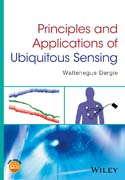
Applications which use wireless sensors are increasing in number. The emergence of wireless sensor networks has also motivated the integration of a large number of small and lightweight nodes which integrate sensors, processors, and wireless transceivers. Existing books on wireless sensor networks mainly focus on protocols and networks and pay little attention to the sensors themselves which the author believes is the main focus. Without adequate knowledge of sensors as well as how they can be designed, realized and used, books on wireless sensor networks become too theoretical and irrelevant. The purpose of this book is to intimately acquaint readers with the technique of sensing (resistive, capacitive, inductive, magnetic, inertial, etc.) and existing sensor technologies. It also discusses how the sensors are used in a wide application domain and how new sensors can be designed and used in a novel way. INDICE: Preface 7 .1 Introduction 1 .1.1 System Overview 2 .1.1.1 Sensing 2 .1.1.2 Conditioning 3 .1.1.3 Analogue to Digital Signal Conversion 3 .1.1.4 Processing 4 .1.2 Example: A Wireless Electrocardiogram 4 .1.3 Organisation of the Book 7 .2 Applications 9 .2.1 Structural Health Monitoring 9 .2.1.1 Bridges and Buildings 10 .2.1.2 Water Pipelines 17 .2.2 Medical Applications 22 .2.2.1 Parkinson s Disease 22 .2.2.2 Alzheimer 26 .2.2.3 Sleep Apnea and Medical Journalling 27 .2.2.4 Asthma 29 .2.2.5 Gastroparesis 31 .2.3 Water Quality Monitoring 34 .References 40 .3 Conditioning Circuits 43 .3.1 Voltage and Current Sources 44 .3.2 Transfer Function 45 .3.3 Impedance Matching 51 .3.4 Filters 56 .3.5 Amplification 62 .3.5.1 ClosedLoop Amplifiers 64 .3.5.2 Difference Amplifier 65 .References 71 .4 Electrical Sensing 73 .4.1 Resistive Sensing 73 .4.2 Capacitive Sensing 80 .4.3 Inductive Sensing 86 .4.4 Thermoelectric Effect 94 .References 98 .5 Ultrasonic Sensing 99 .5.1 Ultrasonic Wave Propagation 104 .5.2 Wave Equation 110 .5.3 Factors Affecting Ultrasonic Wave Propagation 112 .References 115 .6 Optical Sensing 117 .6.1 Photoelectric Effect 119 .6.2 Compton Effect 124 .6.3 Pair Production 130 .6.4 Raman Scattering 132 .6.5 Surface Plasmon Resonance 136 .References 138 .7 Magnetic Sensing 141 .7.1 Superconducting Quantum Interference Devices 141 .7.1.1 DCSQUID 145 .7.1.2 RFSQUID 147 .7.2 Anisotropic Magnetoresistive Sensing 149 .7.3 Giant Magnetoresistance 153 .7.4 Tunnelling Magnetoresistance 159 .7.5 HallEffect Sensing 161 .References 164 .8 Medical Sensing 167 .8.1 Excitable Cells and Biopotentials 168 .8.1.1 Resting Potential 169 .8.1.2 Channel Current 173 .8.1.3 Action Potentials 174 .8.1.4 Propagation of Action Potentials 176 .8.1.5 Measuring Action Potentials 180 .8.2 Cardiac Action Potentials 183 .8.2.1 Propagation of Cardiac Action Potentials 186 .8.2.2 The Electrocardiogram 188 .8.3 Brain Action Potentials 194 .8.3.1 Electroencephalography 199 .8.3.2 Volume Conduction 203 .8.3.3 Electrode Placement 205 .References 208 .9 Microelectromechanical Systems 211 .9.1 Miniaturisation and Scaling 211 .9.1.1 Physical Properties 212 .9.1.2 Mechanical Properties 212 .9.1.3 Thermal Properties 213 .9.1.4 Electrical and Magnetic Properties 214 .9.1.5 Fluid Properties 214 .9.1.6 Chemical Properties 215 .9.1.7 Optical Properties 215 .9.2 Technology 215 .9.2.1 Growth and Deposition 216 .9.2.2 Photolithography 216 .9.2.3 Etching 218 .9.3 Micromachining 218 .9.3.1 Surface Micromachining 219 .9.3.2 Bulk Micromachining 220 .9.4 System Integration 230 .9.5 Micromechanical Sensors 230 .9.5.1 Pressure and Force Sensors 231 .9.5.2 Flow Sensors 238 .9.5.3 Accelerometers 244 .9.5.4 Gyroscopes 248 .References 261 .10 Energy Harvesting 265 .10.1 Factors Affecting the Choice of an Energy Source 265 .10.1.1 Sensing Lifetime 266 .10.1.2 Sensor Load 266 .10.1.3 Energy Source 267 .10.1.4 Storage 268 .10.1.5 Regulation 270 .10.2 Architecture 275 .10.3 Prototypes 277 .10.3.1 Microsolar Panel 278 .10.3.2 Microgenerator 281 .10.3.3 Piezoelectricity 285 .References 287 .11 Sensor Selection and Integration 291 .11.1 Sensor Selection 291 .11.1.1 Accuracy 291 .11.1.2 Sensitivity 294 .11.1.3 Zerooffset 294 .11.1.4 Reproducibility 294 .11.1.5 Span 294 .11.1.6 Stability 294 .11.1.7 Resolution 295 .11.1.8 Selectivity 295 .11.1.9 Response Time 296 .11.1.10 Selfheating 296 .11.1.11 Hysteresis 296 .11.1.12 Ambient Condition 296 .11.1.13 Overload Characteristics 297 .11.1.14 Operating Life 297 .11.1.15 Cost, Size, and Weight 297 .11.2 Comparison by Example 298 .11.2.1 Resistance Temperature Detectors 298 .11.2.2 Thermistors 299 .11.2.3 Thermocouples 300 .11.2.4 Infrared 300 .11.3 Sensor Integration 301 .11.3.1 Dead Volume 301 .11.3.2 Selfheating 302 .11.3.3 Internal Heat Sources 309 .11.3.4 External Heat and Radiation Sources 309 .References 311 .12 Estimation 313 .12.1 Sensor Error as a Random Variable 314 .12.2 Zerooffset Error 318 .12.3 Conversion Error 321 .12.4 Accumulation of Error 325 .12.4.1 The Central Limit Theorem 329 .12.5 Combining Evidence 332 .12.5.1 Weighted Sum 333 .12.5.2 Maximum Likelihood Estimation 340 .12.5.3 Minimum Mean Square Error Estimation 343 .12.5.4 Kalman Filter 346 .12.5.5 The Kalman Filter Formalism 351 .References 354
- ISBN: 978-1-119-09134-9
- Editorial: Wiley–Blackwell
- Encuadernacion: Cartoné
- Páginas: 380
- Fecha Publicación: 13/01/2017
- Nº Volúmenes: 1
- Idioma: Inglés
